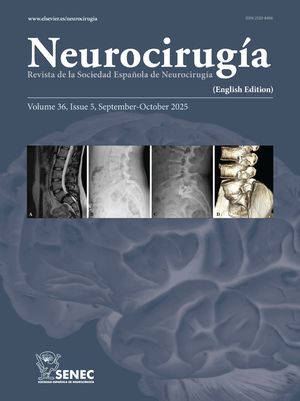La inestabilidad en los segmentos superiores de la columna cervical es un hecho común en pacientes con artritis reumatoide (A.R) de larga evolución. Presentamos 8 pacientes con historia de A.R grave e inestabilidad cervical que han sido tratados con artrodesis posterior. En el momento del tratamiento la duración media de la A.R era de 16.6 años y la de los síntomas 5.7 meses.
En todos los pacientes se evidenció subluxación atlantoaxial reducible, uno de ellos presentaba además impresión basilar.
Las indicaciones quirúrgicas fueron deterioro neurológico progresivo en seis pacientes y subluxación atlantoaxial mayor de 8mm sin signos de compresión medular en dos pacientes.
En cinco casos se realizó artrodesis atlanto-axial; en uno fijación atlanto-C3 y en dos la unión fue occipitocervical. En un paciente se realizó además una odontoidectomía transoral.
El seguimiento medio tras la cirugía fue de 21.1 meses (mínimo 5 meses y máximo 43 meses).
En todos los pacientes mejoraron las parestesias y el dolor cervical. De los seis pacientes que presentaban síntomas neurológicos en el preoperatorio, cinco (83.3%) mejoraron un grado después de la cirugía según la clasificación de Ranawat et al. En siete casos (87.5%) se produjo asimilación del injerto y en uno se constató la reabsorción de éste.
Entre las complicaciones encontramos dos casos de infección de herida quirúrgica; en un paciente se produjo la rotura de los alambres. La mortalidad quirúrgica fue nula.
Upper cervical instability is a relatively common problem in patients with long-standing rheumatoid disease. Eight patients with severe rheumatoid arthritis (R.A.) and cervical instability treated with a posterior arthrodesis are presented. At the time of treatment, the mean duration of the R.A. was 16.6 years and the mean duration of symptoms was 5.7 months.
All patients had reducible atlanto-axial subluxation, one of them with penetration of the dens.
Indications for operative therapy included progressive neurological impairment in six patients and mobile atlantoaxial subluxation greater than 8mm without signs or symptoms of cord compression in two patients.
The surgical treatment was an atlanto-axial arthrodesis in five patients, an atlanto-C3 fusion in one patient and an occipital-cervical arthrodesis in two cases. One patient was in addition submitted to a transoral odontoidectomy.
The average follow-up was 21.1 months (range, five to forty-three months).
Pain and paresthesias were relieved in all patients. Of the six patients with neurologic symptoms, five (83.3%) improved one class level after surgery following the neurological classification of Ranawat et al. Seven (87.5%) of the patients had osseous union, and one had a non-union.
Complications included a superficial wound infection in two cases and a broken wire in one. No patient died postoperatively.
Article

If it is the first time you have accessed you can obtain your credentials by contacting Elsevier Spain in suscripciones@elsevier.com or by calling our Customer Service at902 88 87 40 if you are calling from Spain or at +34 932 418 800 (from 9 to 18h., GMT + 1) if you are calling outside of Spain.
If you already have your login data, please click here .
If you have forgotten your password you can you can recover it by clicking here and selecting the option ¿I have forgotten my password¿.






